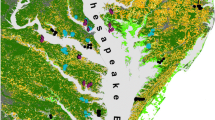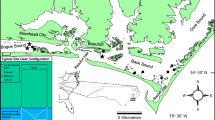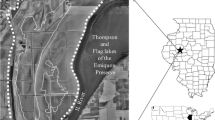Abstract
Functional responses of estuarine fish species to environmental perturbations such as wetland impoundment, changes in water quality, and sediment accretion are investigated. The study focuses on the feeding, growth and habitat use by California killifish (Fundulus parvipinnis), topsmelt (Antherinops affinis), and juvenile California halibut (Paralichthys californicus) in impacted coastal wetlands to provide an ecological basis for guidance on the management and restoration of these ecosystems. The ecology of California killifish, Fundulus parvipinnis, is closely tied with the marsh surface, which they access at high tide to feed and grow. Field estimates of food consumption show that killifish can increase their food intake by two-fold to five-fold by adding marsh surface foods to their diet. Bioenergetics modeling predicts that killifish can grow over an order of magnitude faster if they add intertidal marsh surfaces to their subtidal feeding areas. Tidal inlet closures and increased marsh surface elevations due to sediment accretion can restrict killifish access to the marsh surface, affecting its growth and fitness. An open tidal inlet and tidal creek networks that allow killifish to access the marsh at high tide must be incorporated into the restoration design. Topsmelt and California halibut are also adversely affected by tidal inlet closures. Food consumption rates of topsmelt are 50% lower when the tidal inlet is closed, compared to when the estuary is tidally-flushed. Tidal inlet closures inadvertently induce variations in water temperature and salinity and negatively affect growth of juvenile California halibut. Tidal creek networks which consist of channels and creeks of various orders are also important to halibut. Large halibut (>200 mm TL) inhabit deeper, high order channels for thermal refuge, while small halibut (<120 mm TL) are abundant in lower order channels where they can feed on small-sized prey which are typically less abundant in high order channels. Maintaining an open tidal inlet, implementing sediment management programs and designing coastal wetlands with tidal creek networks adjacent to intertidal salt marsh habitat (for fish access) are key elements that need to be considered during the planning and implementation of coastal wetland restoration projects.


















Similar content being viewed by others
References
Barry JP, Yoklavich MM, Cailliet GM, Ambrose DA, Antrim BS (1996) Trophic ecology of the dominant fishes of Elkhorn Slough, California, 1974–1980. Estuaries 19:115–138
Brinson MM, Rheinhardt R (1996) The role of reference wetlands in functional assessment and mitigation. Ecol Appl 6:69–76
Callaway JC, Zedler JB (2004) Restoration of urban salt marshes: lessons from southern California. Urban Ecosyst 7:133–150
Desmond JS, Zedler JB, Williams GD (2000) Fish use of tidal creek habitats in two southern California salt marshes. Ecol Eng 14:233–252
Elliott JM, Persson L (1978) The estimation of daily rates of food consumption for fish. J Anim Ecol 47:977–991
Horn MH, Allen L (1985) Fish community ecology in southern California bays and estuaries. In: Yaňez-Arancibia A (eds) Fish community ecology in estuaries and coastal lagoons: toward an ecosystem integration. Universidad National Autonoma de Mexico Press México, Cuidad Universiteria, México, pp 169–190
Horn MH, Martin KLM, Chotkowski MA (1999) Intertidal fishes: life in two worlds. Academic Press, San Diego, California
Hyslop EJ (1980) Stomach content analysis—a review of methods and their application. J Fish Biol 17:411–429
Kneib RT (1986) The role of Fundulus heteroclitus in salt marsh trophic dynamics. Am Zool 26:259–269
Kneib RT (1997) The role of tidal marshes in the ecology of estuarine nekton. Ocean Mar Biol: Annu Rev 35:163–220
Kwak TJ, Zedler JB (1997) Food web analysis of southern California coastal wetlands using multiple stable isotopes. Oecologia 110:262–277
Logothetis EA, Horn MH, Dickson KA (2001) Gut morphology and function in Atherinops affinis (Teleostei: Atherinopsidae), a stomachless omnivore feeding on macroalgae. J Fish Biol 59:1298–1312
Madon SP (1998) Low-effort regression estimation of daily ration in young walleye, Stizostedion vitreum. Can J Fish Aquat Sci 55:2058–2066
Madon SP (2002) Ecophysiology of juvenile California halibut Paralichthys californicus in relation to body size, water temperature and salinity. Mar Ecol Prog Ser 243:235–249
Madon SP, Williams GD, West JM, Zedler JB (2001) The importance of marsh access to growth of the California killifish, Fundulus parvipinnis, evaluated through bioenergetics modeling. Ecol Model 136:149–165
Madon SP, West J, Zedler JB (2002) Responses of fish to topographic heterogeneity in an experimental marsh (California). Ecol Restor 20:56–58
Nordby CS, Zedler JB (1991) Responses of fish and macrobenthic assemblages to hydrologic disturbances in Tijuana Estuary and Los Penasquitos Lagoon, California. Estuaries 14:80–93
Onuf CP, Quammen ML, Shaffer GP, Peterson CH, Chapman JW, Cermak J, Holmes RW (1979) An analysis of the value of central and southern California coastal wetlands. In: Greeson PE, Clark JR, Clark JE (eds) Wetland functions and values: the state of our understanding. American Water Resources Association, Minneapolis, Minnesota, pp 186–199
Onuf CP (1987) The ecology of Mugu Lagoon, California: an estuarine profile. Biological, U.S. Department of Interior, Fish and Wildlife Service, National Wetlands Research Center, Report 85 (7.15). Washington, D.C
PERL (Pacific Estuarine Research Laboratory) (1990) A manual for assessing restored and natural coastal wetlands with examples from southern California. California Sea Grant Report No. T-CSGCP-021. La Jolla, California, p. 105
Pinkas L, Oliphant MS, Iverson ILK (1971) Food habits of albacore, bluefin tuna and bonito in California waters. Calif Dept Fish Game, Fish Bull 152:1–105
Post JR (1990) Metabolic allometry of larval and juvenile yellow perch: in situ estimates and bioenergetic models. Can J Fish Aquat Sci 47:554–560
Rozas LP, LaSalle MW (1990) A comparison of the diets of gulf killifish, Fundulus grandis, Baird and Girard, entering and leaving a Mississippi brackish marsh. Estuaries 13:332–336
Swift CC, Haglund TR, Ruiz M, Fisher RN (1993) The status and distribution of the freshwater fishes of southern California. Bull Southern Calif Acad Sci 92:101–167
Thrush SF, Hewitt JE, Cummings VJ, Ellis JI, Hatton C, Lohrer A, Norkko A (2004) Muddy waters: elevating sediment input to coastal estuarine habitats. Front Ecol 2:299–306
Wallace KJ, Callaway JC, Zedler JB (2005) Evolution of tidal creek networks in a high sedimentation environment: A 5-year experiment at Tijuana Estuary, California. Estuaries 28:765–811
Ward KM, Callaway JC, Zedler JB (2003) Episodic colonization of an intertidal mudflat by native cordgrass (Spartina foliosa) at Tijuana Estuary. Estuaries 26:116–130
Weisberg SB, Whalen R, Lotrich VA (1981) Tidal and diurnal influence on food consumption of a salt marsh killifish Fundulus heteroclitus. Mar Biol 61:243–246
Weisberg SB, Lotrich VA (1982) The importance of an infrequently flooded intertidal marsh surface as an energy source for the mummichog Fundulus heteroclitus: an experimental approach. Mar Biol 66:307–310
West JM, Zedler JB (2000) Marsh-creek connectivity: fish use of a tidal salt marsh in southern California. Estuaries 23:699–710
West JM, Williams GD, Madon SP, Zedler JB (2003) Integrating spatial and temporal variability into the analysis of fish food web linkages in Tijuana Estuary. Environ Biol Fish 67:297–309
Williams GD, Zedler JB (1999) Fish assemblage composition in constructed and natural tidal marshes of San Diego Bay: Relative influence of channel morphology and restoration history. Estuaries 22:702–716
Williams P (2001) Restoring physical processes in tidal wetlands. J Coast Res 27:149–161
Williams PB, Orr MK, Garrity NJ (2002) Hydraulic geometry: A geomorphic design tool for tidal marsh channel evolution in wetland restoration projects. Restor Ecol 10:577–590
Zedler JB, Nordby CS, Kus BE (1992) The ecology of Tijuana Estuary, California: A national estuarine research reserve. NOAA Office of Coastal Resource Management, Sanctuaries and Reserves Division, Washington, DC, pp 151
Zedler JB (1996a) Tidal wetland restoration: A scientific perspective and southern California focus. California Sea Grant College System, University of California, La Jolla, CA, USA. Report No. T-038
Zedler JB (1996b) Coastal mitigation in southern California: The need for a regional restoration strategy. Ecol Appl 6:84–93
Zedler JB, Williams GD, Desmond JS (1997) Wetland mitigation: Can fishes distinguish between natural and constructed wetlands? Fisheries 22:26–28
Zedler JB (2001) Handbook for restoring tidal wetlands. CRC press, Boca Raton, Florida
Acknowledgements
This study was supported by funding provided by the Earth Island Institute and the National Science Foundation (NSF Award DEB 0212005) while the author was at the Pacific Estuarine Research Laboratory, San Diego State University. CH2M HILL, Inc. also provided support in time and materials to the author through an initiative grant for data analysis and writing. John Callaway, Janelle West, Michelle Cordrey, Michael Kiener, Brian Weller, Michelle Bowman, Kecia Kerr and Gregory Williams assisted with field sampling and data collection efforts. Thanks are due to Joy B. Zedler for her guidance and support throughout this study. Thanks are also due to the staff at the Tijuana River National Estuarine Research Reserve and the Los Peñasquitos Lagoon Foundation for supporting this research. This paper is dedicated to the memory of Khorshed Shyam Verma.
Author information
Authors and Affiliations
Corresponding author
Rights and permissions
About this article
Cite this article
Madon, S.P. Fish community responses to ecosystem stressors in coastal estuarine wetlands: a functional basis for wetlands management and restoration. Wetlands Ecol Manage 16, 219–236 (2008). https://doi.org/10.1007/s11273-007-9070-6
Received:
Accepted:
Published:
Issue Date:
DOI: https://doi.org/10.1007/s11273-007-9070-6




